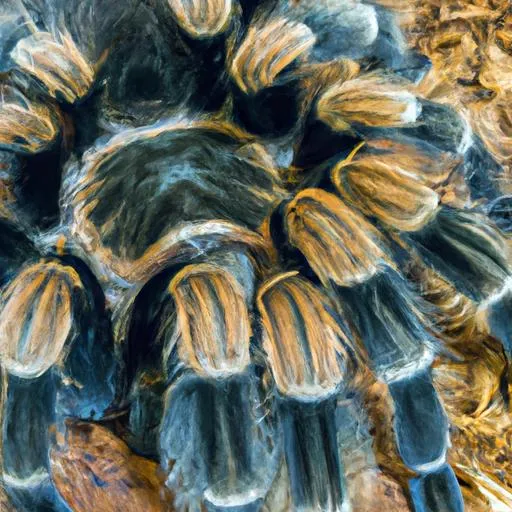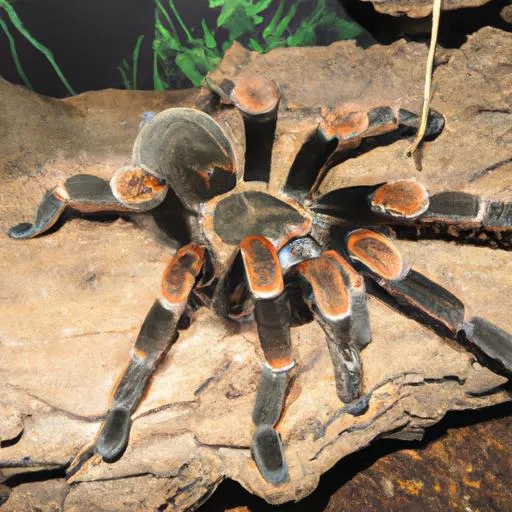What Defines Tarantula Size?
Understanding the size of prehistoric tarantulas requires a grasp of how we measure them today. Tarantula size isn’t as straightforward as it might seem. Several factors contribute to the overall dimensions that scientists and enthusiasts consider. In the context of paleontology and understanding ancient species, defining and measuring size becomes even more complex, relying on the limited evidence available from fossils. Accurate size estimation is crucial to understanding the ecological role of these ancient arachnids, their predatory capabilities, and how they fit into the ecosystems of the past. Measuring these ancient creatures involves different techniques due to the absence of living specimens for direct comparison. The challenges are numerous, yet the insights gained offer a unique window into the lives of these ancient spiders.
Body Size Measurements
Body size in tarantulas is often measured from the front of the cephalothorax (the combined head and chest) to the end of the abdomen. This measurement gives a sense of the overall length of the spider’s main body. However, it is important to consider that the abdomen can vary in size depending on factors such as the spider’s feeding habits, reproductive status, and overall health. Fossilization can also distort these measurements, adding to the complexities of determining body size. Scientists use precise tools and techniques to measure these dimensions when dealing with both living and fossilized specimens. In paleontology, the body size measurements are critical, enabling comparisons with other species, understanding growth patterns, and extrapolating information about the spider’s behavior and environment.
Leg Span Measurement

Perhaps the most visually striking measurement is the leg span, which is the distance from the tip of one front leg to the tip of the opposite leg on the other side of the spider. Leg span provides a sense of the spider’s overall size and how it interacted with its environment. For prehistoric tarantulas, leg span measurements can be challenging to obtain because the legs are often incomplete or damaged in fossilized remains. However, even partial leg measurements can offer valuable insights. Researchers meticulously analyze the remaining leg segments, comparing them to known species and using advanced modeling techniques to estimate the original leg span. This measurement is especially important in understanding how large the spider was and its potential hunting strategies within its ecosystem. This also provides clues about their mobility and how they may have navigated their environment.
How Was Prehistoric Tarantula Size Determined?
Fossil Evidence and Research Methods
Determining the size of prehistoric tarantulas hinges on the analysis of fossil evidence. The process involves a combination of careful observation, advanced imaging techniques, and comparative analysis. Fossils, whether they are imprints, casts, or preserved remains, provide tangible clues. Scientists use microscopes to examine minute details and employ methods like X-ray imaging to visualize the internal structure of the fossils. They then compare the fossilized remains with modern tarantula species to estimate the size and proportions of the prehistoric spiders. This involves the use of morphometrics—the mathematical analysis of form—and the creation of models to estimate the size of missing body parts. The work is meticulous, requiring both paleontological expertise and a deep understanding of arachnid biology to extract as much information as possible from the limited fossil evidence available. This information helps construct a narrative on the lives of these extinct creatures and their place in the past ecosystems.
Challenges in Estimating Size

Estimating the size of prehistoric tarantulas is not without its challenges. The primary hurdle is the incompleteness of fossil records. Spider fossils are often fragmented, which means that scientists must reconstruct the full size from partial remains. The fossilization process itself can cause distortions, altering the original size and shape of the tarantulas. Also, the preservation quality varies; some fossils are exceptionally well-preserved, while others are degraded, making measurements difficult. Furthermore, the availability of comparative data can be limited. If there are few modern species with similar characteristics, it becomes harder to make accurate size estimations. Despite these challenges, researchers continually refine their techniques and leverage advancements in technology to improve the accuracy of their findings. Each new discovery and technological advancement provides a more complete picture of these ancient arachnids.
Comparing Prehistoric Tarantulas to Modern Species
Size Differences
A comparison between prehistoric and modern tarantulas reveals intriguing differences in size and overall morphology. While some prehistoric tarantulas may have been comparable in size to the largest modern species, others appear to have been considerably larger. For example, the extinct giant spider Megarachne servinei was initially estimated to have a leg span of over 50 cm, placing it among the largest arachnids ever discovered. However, later research revealed that it was not a true spider but a relative. Modern tarantulas, while diverse, generally range in leg span from a few inches to around 12 inches. The variations in size are influenced by a combination of factors including evolutionary pressures, environmental conditions, and dietary habits. Comparing fossils with current species helps scientists understand the evolution of these species and their adaptation to changing environments throughout the ages.
Habitat and Diet Influences

The size of a tarantula, both prehistoric and modern, is influenced by its habitat and diet. In the prehistoric era, spiders lived in varied environments, ranging from lush, tropical forests to more arid landscapes. The abundance of food resources and the absence or presence of predators had a significant impact on size. Species in environments with plentiful prey, such as large insects or even small vertebrates, may have had an evolutionary advantage in growing larger. Conversely, environments with limited resources or the presence of formidable predators could have led to smaller sizes as a survival strategy. The study of fossilized remains can also reveal clues about the diet, which is vital for determining the relationship between size and food sources. This includes studying the structure of their mouthparts to determine what they ate. This ecological relationship highlights the intricate interplay between spiders and their environments over millions of years.
Giant Tarantula Discoveries
Megarachne Compared
Megarachne servinei is one of the most famous examples of giant prehistoric arachnids. Discovered in Argentina, its initial classification as a giant spider caused excitement. It was estimated to have a leg span of over 50 cm, putting it in the same size class as the largest modern spiders. However, further analysis reclassified Megarachne not as a true spider but as a close relative. Even though its true identity was revised, the fossil remains were still exceptional. They gave scientists valuable information on the diversity of arachnids that lived in the past. The detailed fossil provided insights into its body structure, including the shape of its cephalothorax and the arrangement of its appendages. This case illustrates both the thrill and the challenges of paleontological research—the initial discovery of what appeared to be the world’s largest spider served as a reminder of the remarkable creatures that have inhabited our planet.
Other Notable Giant Spiders

Beyond Megarachne, several other notable giant spiders have been found in the fossil record. These include species that, while not as massive, were still significantly larger than many of their modern counterparts. Fossil discoveries in places like the United States, Europe, and Australia have revealed a range of prehistoric tarantulas, each offering insights into the evolution of arachnids. Each species contributed to the understanding of how spider size evolved over millions of years. Scientists study these fossils in detail, looking at factors like leg span, body shape, and the structures of their chelicerae (mouthparts), helping piece together a more complete picture of the prehistoric arachnid world. This includes comparing them with the environment in which they lived. Fossil sites provide scientists with a detailed understanding of how these ancient creatures survived.
Factors Influencing Tarantula Size Evolution
Environmental Conditions
Environmental conditions played a critical role in shaping the size of prehistoric tarantulas. Factors such as climate, the availability of resources, and the composition of the ecosystem influenced the evolution of these spiders. During periods of warmer climates and abundant food supplies, spiders may have been able to grow larger. Specific environmental factors also provided opportunities for gigantism. The absence of certain predators or the presence of specific types of prey could have driven the selection for larger sizes. In contrast, during times of environmental stress or change, such as ice ages or habitat loss, there may have been a selection for smaller spiders that could more efficiently utilize resources. The study of these environmental variables helps researchers to understand the evolutionary trajectory of tarantulas and how they adapted over millions of years.
Predator-Prey Dynamics

The predator-prey dynamics within the prehistoric ecosystem also played an important role in determining the size of tarantulas. The presence of larger predators, such as other spiders or ancient reptiles, could have put pressure on tarantulas to evolve to a smaller size, making them less vulnerable to attack. Conversely, the absence of predators could have allowed spiders to grow larger without fear of predation. The size of prey also had a big impact. Tarantulas may have grown larger if their diet consisted of larger insects and small vertebrates. The interplay between predator and prey creates a complex relationship that greatly influences the characteristics of species. Paleontologists analyze the fossil records and reconstruct the relationships between various species to better understand the evolutionary strategies and adaptations that drove size changes in prehistoric tarantulas.
Why Did Tarantula Size Change?
The question of why tarantula size changed over time is multifaceted, influenced by a combination of environmental pressures, genetic variations, and the dynamics of the ecosystem. As environments shifted, spiders adapted to new challenges and opportunities. Climate change, variations in food availability, and the presence or absence of predators all played their parts in driving the evolutionary trajectory. The ongoing evolution of tarantulas allows them to survive and thrive in various environments. Understanding the reasons behind these changes also requires studying the genetic make-up of tarantulas and how genetic mutations could have influenced their body size. Each discovery helps to further understand how these changes have occurred.
The Future of Tarantula Size Research
The future of research into prehistoric tarantula size is bright, with new technologies and techniques continually emerging. Advancements in imaging technology, such as high-resolution X-ray scanning and 3D modeling, provide detailed insights into fossil structures, allowing researchers to make increasingly accurate measurements and size estimations. Genetic analysis is also playing a crucial role. By extracting and analyzing ancient DNA from spider fossils, scientists can gain a deeper understanding of the genetic factors that controlled size. Furthermore, the development of new data analysis methods and the use of computer simulations helps researchers to test different hypotheses about the evolution of these species. This includes comparing data sets and drawing conclusions to further advance scientific understanding. New discoveries are continually changing our understanding of the past. As the field of paleontology continues to evolve, the secrets of prehistoric tarantula size will continue to be revealed, further enriching our knowledge of the history of life on Earth.
